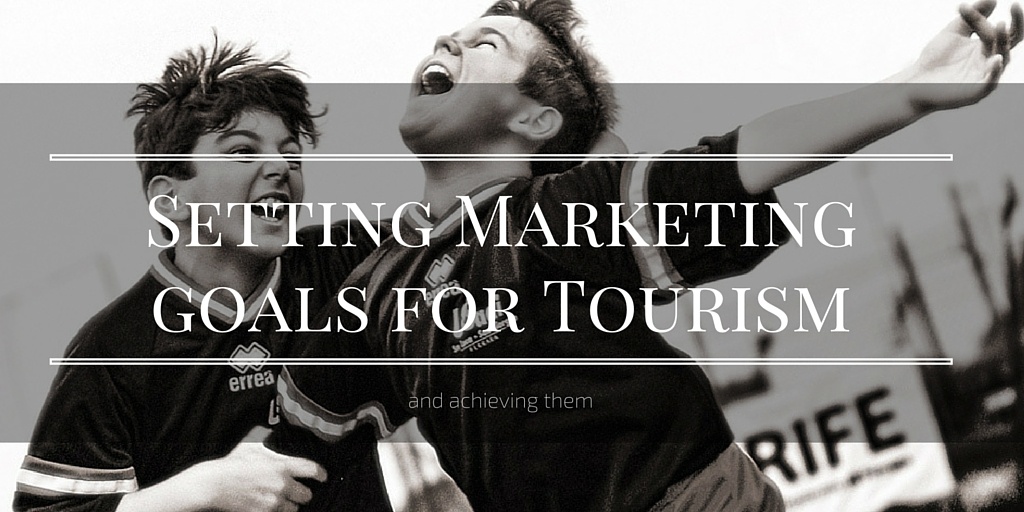Setting Marketing Goals for Tourism

I recently was having a conversation with a close friend about marketing and the topic of Tourism Marketing Plans came up. As we discussed what “the best” tourism marketing plans were, we decided to throw that term into Google to see what we got. The results are a mixed bag.
There are a lot of DMO 5 year plans that are full of research, numbers, objectives, and strategies. Other results explain tactics on how to build “the best” tourism marketing plan. The one thing that I found a bit surprising and consistent with the first page results on Google, is that each result does not talk or goes really light about setting goals. I’m not exactly sure why goals are left off, but when we work with clients, setting goals and building marketing plans are like peanut butter and jelly.
So what does it take to set marketing goals for tourism? You need to be results driven to push to achieve the goal, willing to fail and adjust because you may not always hit your set goal, and you need to be SMART. SMART is a methodology that helps you establish concrete and achievable goals. SMART stands for Specific, Measurable, Attainable, Relevant, and Time-bound. The reality is that 90% of us know what we want to accomplish, but we keep it all in our heads. Using the SMART methodology is a process to make the goals a reality. And if you don’t achieve them, make adjustments and set your aim again. In tourism marketing, there are tons of things you’re measuring for success. Set your goals early, WRITE THEM DOWN and you will see consistent success.
Ready? Let’s get SMART.
SPECIFIC
When creating a goal, you want it to be as short, crisp, and specific as possible. Having “a good marketing year” isn’t a reflection of what your company actually accomplished. Imagine that your boss is about to leave for vacation, and you have less than 90 seconds until he/she runs out the door, and all they want is to quickly hear what next year’s goal is – what are you going to tell him or her that concisely explains your plans?
MEASURABLE
Oftentimes, companies say they want to “increase their social media following.” While that is a goal, it’s not a trackable goal. If you start the new year with 100 followers, and end with 101, technically you met your set goal. But if you switch that goal to read, “We want to increase social media following by 25%,” suddenly you can measure your progress every month to see if you’re on track to ultimately jumping from 100 to 125 followers. Now you really know you hit your goal – hopefully it’s more ambitious than this example!
ATTAINABLE
While having history-breaking goals are beneficial it’s still important to keep these goals realistic. If in your company history you’ve generated an average of 10 leads every month, jumping to 2,000 leads per month would be a drastic change. Many businesses do this to push employees and to “go as far as they possible can.” But in reality, all this does is discourage the worker, as he/she sees they can never actually be successful. SMART goals are goals you can actually achieve.
RELEVANT
Why have a goal if the goal doesn’t matter? Say you’re a teddy bear business that, at maximum, can only sell 1,000 teddy bears per month. In this situation, your goal likely shouldn’t be to “increase production of teddy bears from 1,000 per month to 5,000 per month.” While it’s great you have more product, if your existing distributors won’t buy more, why bother? Your goal should be something along the lines of, “increase distribution channels by X%.”
TIME-BOUND
While having all the aforementioned helps develop a solid goal, you need to ensure you have a timeline for meeting that goal. Going back to the teddy bear example, if you do decide your goal is to increase distribution channels, you need to know when you will accomplish this in order to know when to start working on a secondary goal of increasing teddy bear production. You don’t want a situation where you end up with more toy stores taking your teddy bears, but no teddy bears to give. Oh the horror!
To make using the SMART Marketing methodology easy, we’re giving you a free download to the SMART Marketing Goal-Setting Excel Template. Click on the link below to start setting your marketing goals for tourism and see your business GROW!
(Photo credit: brtsergio via VisualHunt.com / CC BY-NC-SA)
